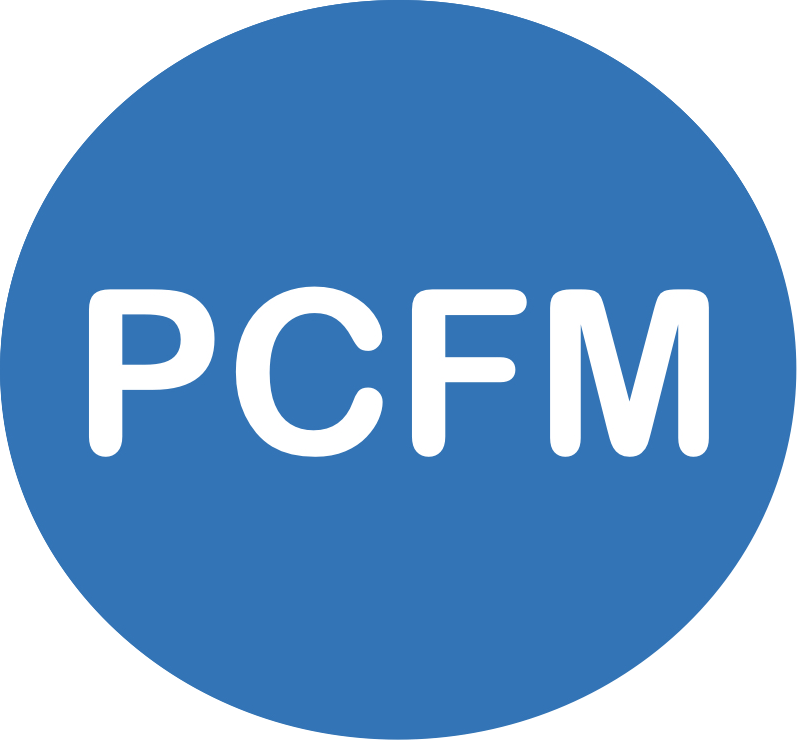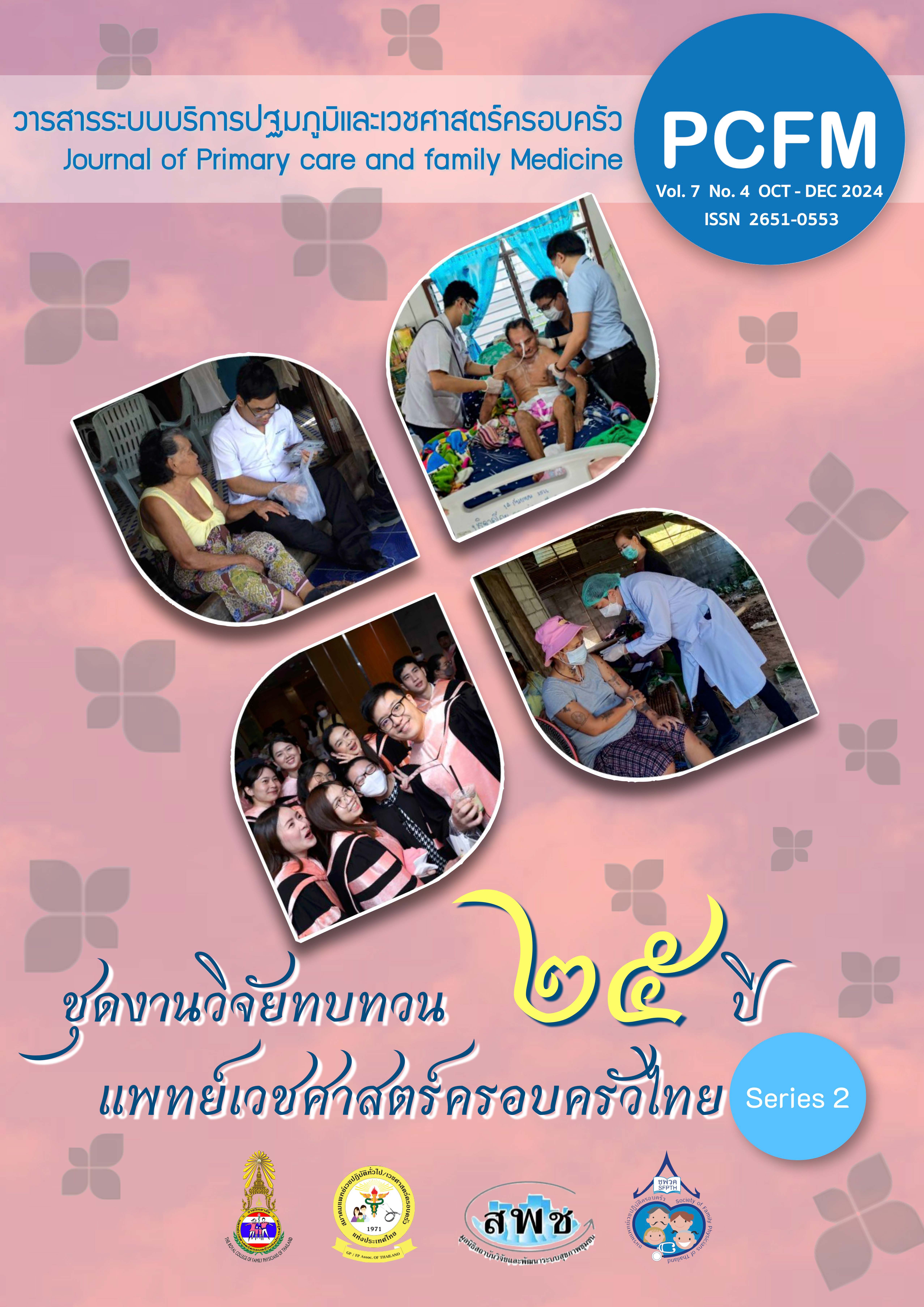ปัจจัยที่เกี่ยวข้องกับความปวดลดยากในผู้ป่วยระยะท้ายช่วง 48 ชั่วโมงแรกของการรับปรึกษาประคับประคอง
Main Article Content
บทคัดย่อ
ที่มา: ความปวดเป็นอาการที่ทำให้ผู้ป่วยระยะท้ายไม่สุขสบาย หากปล่อยไว้นานอาจทำให้ความปวดจัดการได้ยาก ทีมประคับประคองจึงมุ่งเน้นการลดความปวดใน 48 ชั่วโมงแรกหลังรับปรึกษา อย่างไรก็ตามผู้ป่วยบางรายลดปวดยาก ผู้วิจัยจึงต้องการศึกษาปัจจัยที่เกี่ยวข้องกับความปวดลดยากในช่วงแรกของการรับปรึกษาประคับประคอง
แบบวิจัย: การศึกษาจากเหตุไปหาผลแบบย้อนหลัง
วัสดุและวิธีการ: ผู้ป่วยประคับประคองที่มีความปวดปานกลางขึ้นไปจะถูกนำเข้าการศึกษา หลังคัดผู้ที่ไม่สามารถประเมินความปวดด้วยตนเองออกแล้ว จึงทบทวนข้อมูลพื้นฐาน การรักษาความปวด และคะแนนปวดใน 48 ชั่วโมง ปัจจัยที่เกี่ยวข้องกับความปวดลดยากใช้วิธีวิเคราะห์แบบถดถอยโลจิสติก
ผลการศึกษา: ผู้ป่วยประคับประคอง 997 คน ร้อยละ 11.03 มีความปวดลดยาก พบปัจจัยที่เกี่ยวข้อง ได้แก่ อายุ การกลืนลำบาก อาการต่อไปนี้ที่มีระดับรุนแรง ได้แก่ คลื่นไส้ ซึมเศร้า วิตกกังวล ง่วงซึม เบื่ออาหาร และไม่สบายกายและใจ ส่วนปัจจัยที่เกี่ยวข้องโดยตรงได้แก่ อายุ การกลืนลำบาก และซึมเศร้ารุนแรง (OR 0.98, 95%CI 0.97-0.99, p-value 0.007, OR 1.83, 95%CI 1.03-3.27, p-value 0.040, และ OR 1.73, 95%CI 1.04-2.89, p-value 0.035 ตามลำดับ)
สรุป: อายุ การกลืนลำบาก และซึมเศร้ารุนแรง เป็นปัจจัยที่เกี่ยวข้องโดยตรงกับความปวดลดยากในผู้ป่วยประคับประคอง จึงควรมีการจัดการภาวะซึมเศร้าอย่างเหมาะสมควบคู่การจัดการความปวดเพื่อช่วยให้ผลลัพธ์ดีขึ้น
คำสำคัญ: ปัจจัย ความปวดลดยาก ประคับประคอง ผู้ป่วยระยะท้าย
Article Details

This work is licensed under a Creative Commons Attribution-NonCommercial-NoDerivatives 4.0 International License.
เนื้อหาและข้อมูลในบทความที่ลงตีพิมพ์ในวารสาร PCFM ถือเป็นข้อคิดเห็นและความรับผิดชอบของผู้เขียนบทความโดยตรง ซึ่งกองบรรณาธิการวารสารไม่จำเป็นต้องเห็นด้วยหรือร่วมรับผิดชอบใด ๆ
บทความ ข้อมูล เนื้อหา รูปภาพ ฯลฯ ที่ได้รับการตีพิมพ์ลงในวารสาร PCFM ถือเป็นลิขสิทธิ์ของวารสาร PCFM หากบุคคลหรือหน่วยงานใดต้องการนำทั้งหมดหรือส่วนหนึ่งส่วนใดไปเผยแพร่ต่อหรือเพื่อกระทำการใด ๆ จะต้องได้รับอนุญาตเป็นลายลักษณ์อักษรจากวารสาร PCFM ก่อนเท่านั้น
References
Chang VT, Sorger B, Rosenfeld KE, Lorenz KA, Bailey AF, Bui T, et al. Pain and palliative medicine. J Rehabil Res Dev. 2007;44:279-94.
Pantilat SZ, O’Riordan DL, Rathfon MA, Dracup KA, De Marco T. Etiology of pain and its association with quality of life among patients with heart failure. J Palliat Med. 2016;19:1254-9.
Meuser T, Pietruck C, Radbruch L, Stute P, Lehmann KA, Grond S. Symptoms during cancer pain treatment following WHO-guidelines: a longitudinal follow-up study of symptom prevalence, severity and etiology. Pain. 2001;93:247-57.
Rodriguez C, Ji M, Wang HL, Padhya T, McMillan SC. Cancer pain and quality of life. J Hosp Palliat Nurses Assoc. 2019;21:116-23.
Heinricher MM. Pain modulation and the transition from acute to chronic pain. Adv Exp Med Biol. 2016; 904:105-15.
Silva MADS, Diniz MA, Carvalho RT, Chiba T, Mattos-Pimenta CA. Palliative care consultation team: symptom relief in first 48 hours of hospitalization. Rev Bras Enferm. 2020;73(6):e20190391. PubMed PMID: 32785516
Lucenteforte E, Vagnoli L, Pugi A, Crescioli G, Lombardi N, Bonaiuti R, Aricò M, Giglio S, Messeri A, Mugelli A, Vannacci A, Maggini V. A systematic review of the risk factors for clinical response to opioids for all-age patients with cancer-related pain and presentation of the paediatric STOP pain study. BMC Cancer. 2018;18:568. PubMed PMID: 29776346
Chewaskulyong B, Sapinun L, Downing GM, Intaratat P, Lesperance M, Leautrakul S, et al. Reliability and validity of the Thai translation (Thai PPS Adult Suandok) of the Palliative Performance Scale (PPSv2). Palliat Med. 2012;26:1034-41.
Chinda M, Jaturapatporn D, Kirshen AJ, Udomsubpayakul U. Reliability and validity of a Thai version of the edmonton symptom assessment scale (ESAS-Thai). J Pain Symptom Manage. 2011;42:954-60.
Selby D, Cascella A, Gardiner K, Do R, Moravan V, Myers J, et al. A single set of numerical cutpoints to define moderate and severe symptoms for the Edmonton Symptom Assessment System. J Pain Symptom Manage. 2010;39:241-9.
Lefkowits C, Teuteberg W, Courtney-Brooks M, Sukumvanich P, Ruskin R, Kelley JL. Improvement in symptom burden within one day after palliative care consultation in a cohort of gynecologic oncology inpatients. Gynecol Oncol. 2015;136:424-8.
Fainsinger RL, Nekolaichuk CL, Lawlor PG, Neumann CM, Hanson J, Vigano A. A Multicenter Study of the Revised Edmonton Staging System for Classifying Cancer Pain in Advanced Cancer Patients. J Pain Symptom Manage. 2005;29:224-37.
Mercadante S, Casuccio A, Pumo S, Fulfaro F. Factors influencing the opioid response in advanced cancer patients with pain followed at home: the effects of age and gender. Support Care Cancer. 2000;8:123-30.
Wong G. Pharmacological management of chronic non-cancer pain in frail older people. Aust Prescr. 2022; 45:2-7.
Perusinghe M, Chen KY, McDermott B. Evidence-Based Management of Depression in Palliative Care: A Systematic Review. J Palliat Med [Internet]. 2021 Apr 19 [cited 2023 Sep 10]; Available from: https://www.liebertpub.com/doi/10.1089/jpm.2020.0659
Mercadante S, Adile C, Ferrera P, Cortegiani A, Casuccio A. Symptom hyper-expression in advanced cancer patients with anxiety and depression admitted to an acute supportive/palliative care unit. Support Care Cancer. 2019;27:3081-8.
Delgado-Guay M, Parsons HA, Li Z, Palmer JL, Bruera E. Symptom distress in advanced cancer patients with anxiety and depression in the palliative care setting. Support Care Cancer. 2009;17:573-9.
Michaelides A, Zis P. Depression, anxiety and acute pain: links and management challenges. Postgrad Med. 2019;131:438-44.
Zis P, Daskalaki A, Bountouni I, Sykioti P, Varrassi G, Paladini A. Depression and chronic pain in the elderly: links and management challenges. Clin Interv Aging. 2017;12:709-20.
Teh CF, Zaslavsky A, Reynolds CF, Cleary PD. Effect of depression treatment on chronic pain outcomes. Psychosom Med. 2010;72:61-7.
Wiffen PJ, Derry S, Moore RA. Impact of morphine, fentanyl, oxycodone or codeine on patient consciousness, appetite and thirst when used to treat cancer pain. Cochrane Database Syst Rev. 2014;2014(5):CD011056. PubMed PMID: 24874470
Porreca F, Ossipov MH. Nausea and vomiting side effects with opioid analgesics during treatment of chronic pain: mechanisms, implications, and management options. Pain Med Malden Mass. 2009;10:654-62.
Kelly J, Wright D. Administering medication to adult patients with dysphagia. Nurs Stand R Coll Nurs G B 1987. 2009;23(29):62-8.
Pergolizzi JV, Taylor R, Nalamachu S, Raffa RB, Carlson DR, Varanasi RK, et al. Challenges of treating patients with chronic pain with dysphagia (CPD): physician and patient perspectives. Curr Med Res Opin. 2014;30:191-202.

